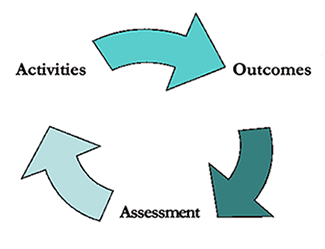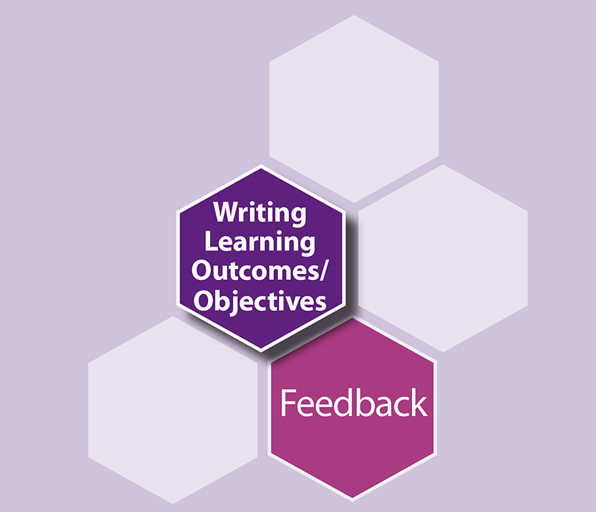Introduction

Outcome statements/objectives play an important role in helping students learn. They orient the student to the learning task and specify what students should pay attention to. They also help to focus the teacher to the goal of instruction, the central purpose, which is learning for the students or learners.
Outcome statements can be broad & comprehensive in scope (sometimes called program outcomes/objectives, especially in undergraduate medical education, and competencies and Entrustable Professional Activities – EPAs, especially in postgraduate medical education).
Outcomes can also be narrow, identifying specific skills, attitudes, & abilities at the session level (what we usually call objectives).
Outcomes are also part of the alignment of the entire learning experience. We need to connect the outcomes, activities, and assessment clearly and directly: learning activities need to support the specific outcomes & the assessment program should mirror those outcomes and learning activities.
Learning Outcomes for the CORAL Cell on learning outcomes (what you can reasonably expect to learn in the next 15 minutes):
- Describe the elements of effective learning outcomes/objectives.
- Critique learning outcomes based on known characteristics of effective objectives.
- Write effective learning outcomes in an area of (relative) expertise.
To what extent are you able to meet these outcomes? Please record your self-assessments. (1 is not at all and 5 is completely)
Before we get started, consider for a moment learning outcomes you have written and those you have encountered as a learner. What features seem to be characteristic of them all?
Learning about learning outcomes

Learning outcomes need to:
- describe what the student will be able to do at the end of the session
- represent real & important goals, and
- be clearly communicated to the learners
Instructors can also use learning outcomes to guide course and module development, creation of teaching materials, and assessment plans for students (your assessment should always align with the verb in your learning outcome/objective).
Outcomes are not activities or outputs. A learning outcome is not what students will do to develop the skill (for example, “the student will read pages 5-6 and answer question a-e”, is a learning activity not an outcome.) Outcomes are all about where students will end up, not how they will get there!
Answering the following questions will help you to write learning outcomes:
- What do I expect the learner to be able to do as a result of my instruction?
- How will the learner demonstrate that he/she has learned the right content? In other words, what will your assessment method(s) be?
Some General Considerations for Outcomes: SMART
Student Centered:
The outcomes must express what the student(s) will be able to do once the instruction concludes. Here is a good example, “Given a brief case, students will be able to identify symptoms of endocarditis. Outcomes do not describe what the instructor will do or hopes to do (“I will talk about endocarditis.”). Outcomes also do not describe what student(s) will do to learn the material (“Students will complete a case report on a patient with endocarditis.”). Outcomes describe the learner’s new learning as knowledge, attitude, or behaviour.
Measureable:
Outcomes need to be plainly measurable (observable) in some written, oral, OSCE, or direct format. If they are not measurable, there may be widespread disagreement about whether or to what extent the student has achieved the outcome. That is why we never use the verbs ‘understand’ or ‘know’ as they are ambiguous terms that cannot be measured.
Achievable:
The learning expected of the student must also be achievable under the constraints of time & place. There are few things more frustrating & demotivating than objectives that students cannot possibly meet.
Relevant:
The outcomes need be relevant: they must pertain to the important goals of the course & the overall program. The reason for learning cannot simply be to pass the exam and never to display the instructor’s clinical or research interests.
Timely:
The outcomes need to fit within a reasonable period of learning for that course, rotation, or block. We should arrange for the prerequisites knowledge and skills close to the new instruction & future content needs to reinforce and build on the new material.
Further considerations:
Degree: Specifies the acceptable level of performance (ex: Calculate the metabolic rate to two decimal places).
Condition(s): Requirements under which the student is expected to perform the described behaviour (ex: Given the appropriate instruments and a human adult simulator, perform an intubation).
Verbs used in outcomes (to see an extensive list of appropriate verbs, please visit the TIPS for Residents manual – page 15)
Use: list, describe, explain, solve, apply, assemble, identify, and discriminate
Do not use: know, become familiar with, appreciate, grasp, understand
Examples of specific outcomes for medical education: (Notice the highlighted verb that states what the student will be able to do)
- From memory, the student will be able to describe the mechanisms of action, the pharmacological effects, the therapeutic actions, and the adverse effects of lithium.
- Provided with the necessary equipment, the student will be able to intubate a patient with minimum discomfort to the patient.
Examples of poorly written outcomes (learning objectives):
- Students will be able to understand the theory of evolution. (Critique: What do the students need to understand? How would you assess their understanding? Why would medical students need to know this?)
- The student will know what to do for the woman in labour. (Critique: What exactly do the students need to know: delivery procedures, identification of labour complications, or administration of anesthetic?)
Outcome Vocabulary in Medical Education
UGME
The College of Medicine uses the term “objectives” for both broad & specific learning outcomes in the undergraduate program. “Program objectives” are outcomes at the highest level with “Course objectives”, “Module objectives”, & “Session objectives” falling within those broader outcomes, & becoming more specific.
PGME
The College of Family Physicians of Canada & the Royal College of Physicians & Surgeons of Canada have both adopted a competency-based framework for education (Competency Based Medical Education is often abbreviated CBME). Seven CanMEDS roles are the guiding principles for the Royal College. Family Medicine has adopted these seven roles & has adapted them to align with the Four Principles of Family Medicine.
Under the seven roles, both Colleges have identified key & enabling competencies for physicians. Competencies describe broad outcomes; expected skills at the end of a learner’s training. Learning objectives are more discrete skills & abilities necessary to build up to the more comprehensive competencies.
Professional bodies have recently introduced Entrustable Professional Activities (EPAs). They describe discipline-specific tasks faculty expect competent learners to be able to perform (such as admitting a patient, performing a surgical technique, diagnosing an illness). EPAs often involve the attainment of several learning outcomes but are less broad than end of program competencies.
The objectives for any single teaching session are part of a more complex framework of medical competencies. You may really be interested in Y, but Y needs to fit into the larger framework of expectations that your learners need to meet. Learning objectives need to build toward the broader competencies for your specialty. It is therefore important if you are developing objectives within a program such as UGME, that you use the processes they have in place for review and approval of objectives.
Example Key Competency:
Respond to an individual patient’s health needs by advocating with the patient within and beyond the clinical environment.
Possible related EPA:
Work with patients to address determinants of health that affect them and their access to needed health services or resources.
Learning Objectives:
Describe elements of patient health literacy.
Help patients understand health strategies relevant to their situations.
Check for Understanding
Self-assessment
To what extent are you NOW able to meet these outcomes? Please record your self-assessments (1 is not at all and 5 is completely)
To what extent before beginning this Cell were you able to meet these outcomes? Please record your self-assessments (1 is not at all and 5 is completely).

Thank you for completing this CORAL Cell. We are interested in improving this and other cells and would like to use your answers (anonymously of course) along with the following descriptive questions as part of our evaluation data.
Thanks again and please come back soon!
The CORAL Cell Team
References and further reading:
Credits:
- Authors: Marcel D’Eon, Sean Polreis, Deirdre Bonnycastle (University of Saskatchewan)
- Senior Editor: Marcel D’Eon
- Reviewer/Consultant: Cathy MacLean, Bev Karras
- Concept map of related CORAL Cells: Teaching Tool Kit
- Writing learning outcomes (objectives), Set, body, closure; Using questions effectively; (Narrative) Feedback
